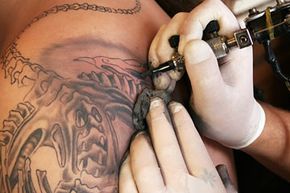Tattoos are all the rage today, and understandably so. Body art is a terrific form of self-expression and a great way to display your individuality. Just remember one key fact: For all intents and purposes, you're making a permanent statement with your tattoo; removal is possible, but typically a much more difficult and painful process than the original treatment. As a result, you should put a great deal of thought into the decision.
The application of a tattoo is, by nature, an invasive procedure. The first question to consider is whether getting a tattoo will harm your skin. Tattoos, once healed, pose little risk for your epidermis. However, getting a tattoo does involve needles and ink, and issues can arise when complications occur during the application and healing process.
Advertisement
A tattoo is essentially a series of needle-induced punctures that insert dye or pigment into different levels of the skin. When done correctly and in a sterile environment, complications are rare, and the only immediate discomforts may be minor bleeding or pain. Still, it's important to keep an eye out for potential complications in the hours and days after you've gotten a tattoo.
One potential risk is bacterial infection at the tattoo site. Symptoms include redness, warmth or a pus-like drainage. This is a primary reason why you should be vigilant about keeping the tattoo site clean until it's fully healed. You may also have a reaction to the tattoo, where bumps or nodules (called granulomas), or excessive scarring (keloids), may appear. Some people can even have a serious allergic reaction to the types of dyes or pigments used in tattoos. These reactions are difficult to treat, since the pigments are difficult to remove, so it's important to leave the tattoo parlor with a list of the types of dyes used, just in case of emergency [sources: WebMD; MedicineNet].
A more serious risk is the spread of infectious disease, which can be avoided by being particular about the tattoo parlor you use. Find a parlor that is not only reputable, but also complies with all state and local licensing. Diseases such as hepatitis B, hepatitis C, tuberculosis, tetanus or HIV can spread if an artist uses dirty equipment. To be safe, make sure that the parlor uses an autoclave, or a heat sterilization machine, on all non-disposable equipment before you get your tattoo. Even new needles and tubes should be removed from packaging and sterilized before every tattoo job [source: Mayo Clinic].
Dermatology experts also warn that tattoos can hide moles that can be early signs of dangerous skin conditions, such as melanoma. This potentially deadly and aggressive form of skin cancer is most successfully treated when discovered early, so the ability to detect irregularities is critical. Also, experts suggest that pregnant women forego tattoos until they give birth, since tattoo inks are largely unregulated and could pose a risk for an unborn baby [source: AAD].
Some tattoo recipients have reported swelling or burning sensations around the affected area during MRI (magnetic resonance imaging) testing. Mascara can have a similar effect, but, unlike tattoos, can be easily removed. Tattoo ink an also adversely affect the quality of the images [source: MedicineNet].
To ensure proper healing of your new tattoo, closely follow all instructions from your tattoo artist. If you keep these potential risks in mind and carefully select your tattoo parlor, a tattoo can be a safe form of body art. To protect your new accessory, make sure to always apply sunscreen (SPF 30 or higher) before going outside, avoid sunlamps and tanning beds or booths, and use a water-based lotion to keep skin well hydrated (petroleum-based products can fade tattoo ink) [source: AAD].
Finally, remember that your physique, and especially your skin, is bound to change over time. Wrinkles, and stretched skin, are often an unavoidable byproduct of aging. Think of what your body will look like 10, 20 or even 30 years from now, and keep that in mind when choosing a tattoo and its location.
See the links and resources on the next page for more information.
Advertisement

